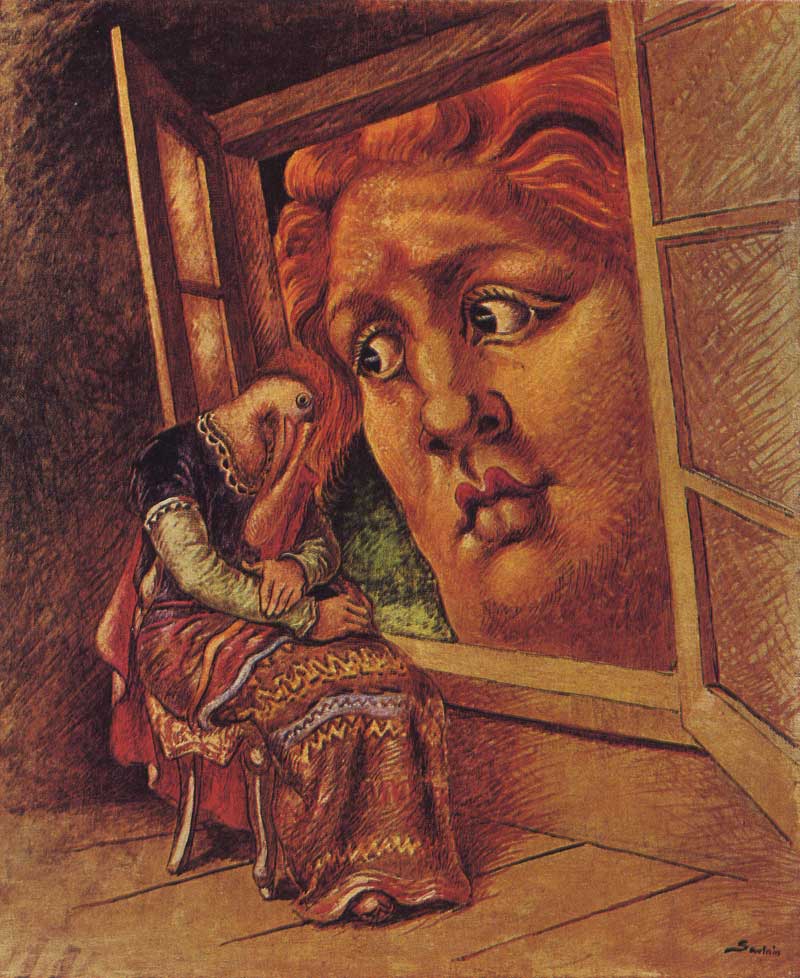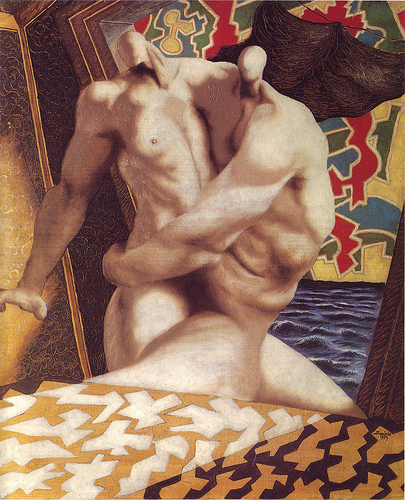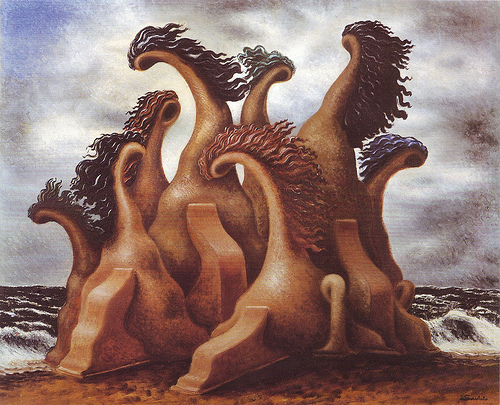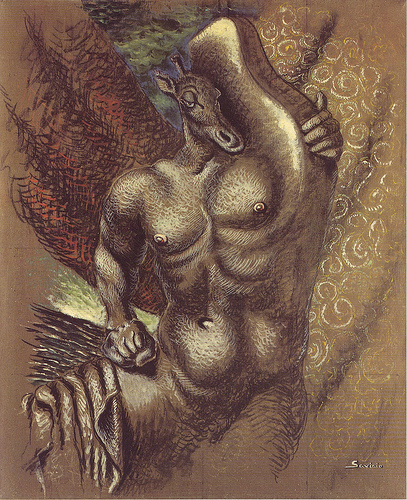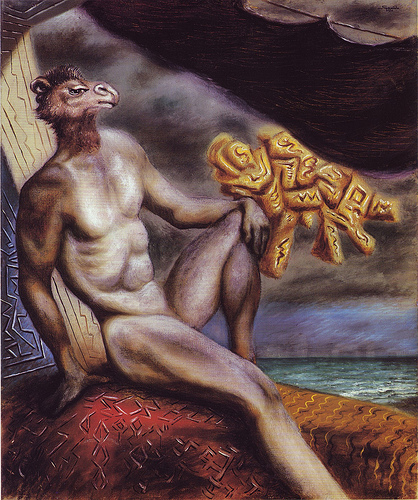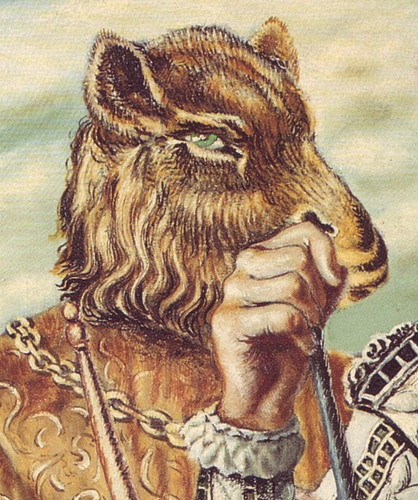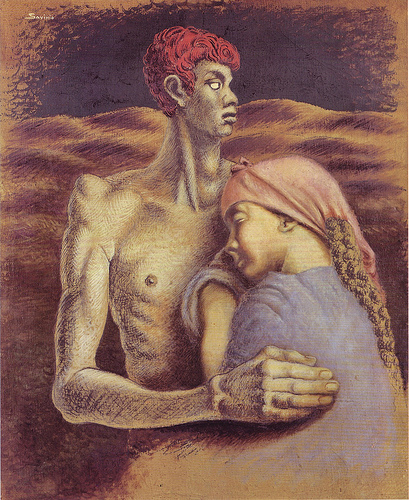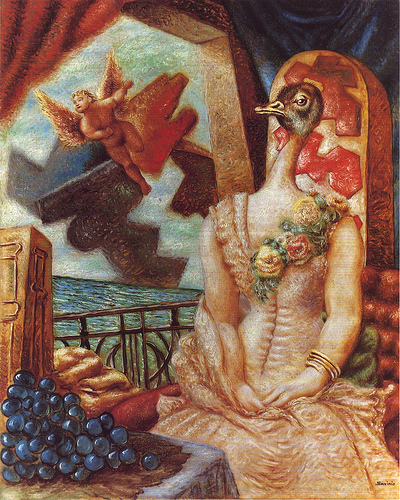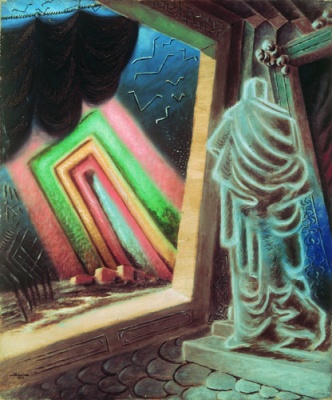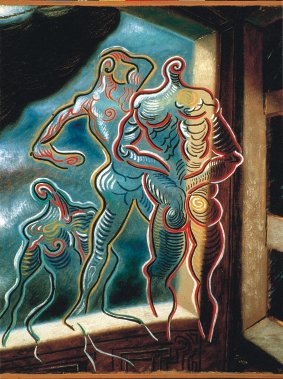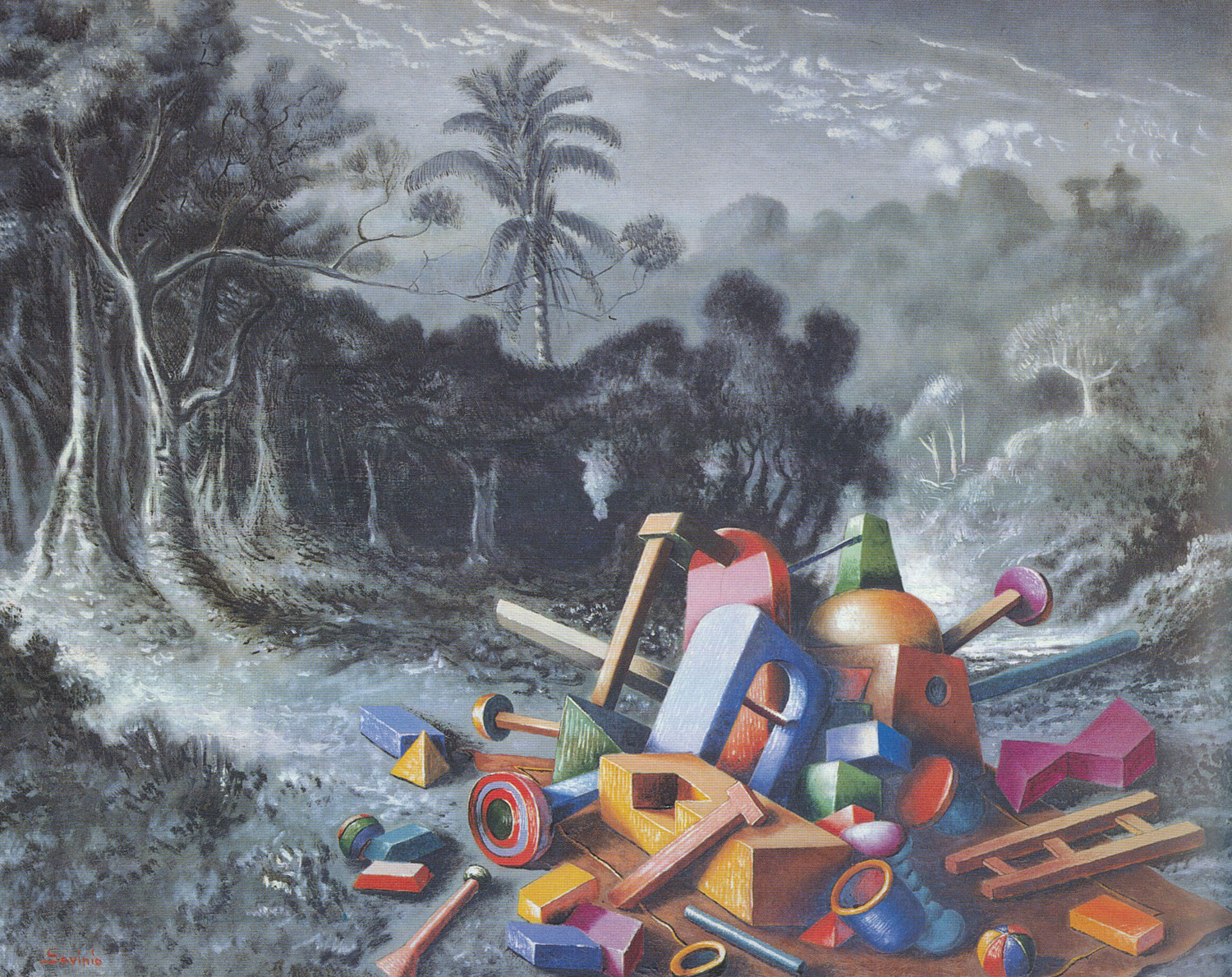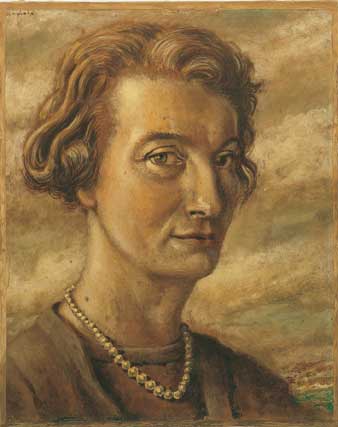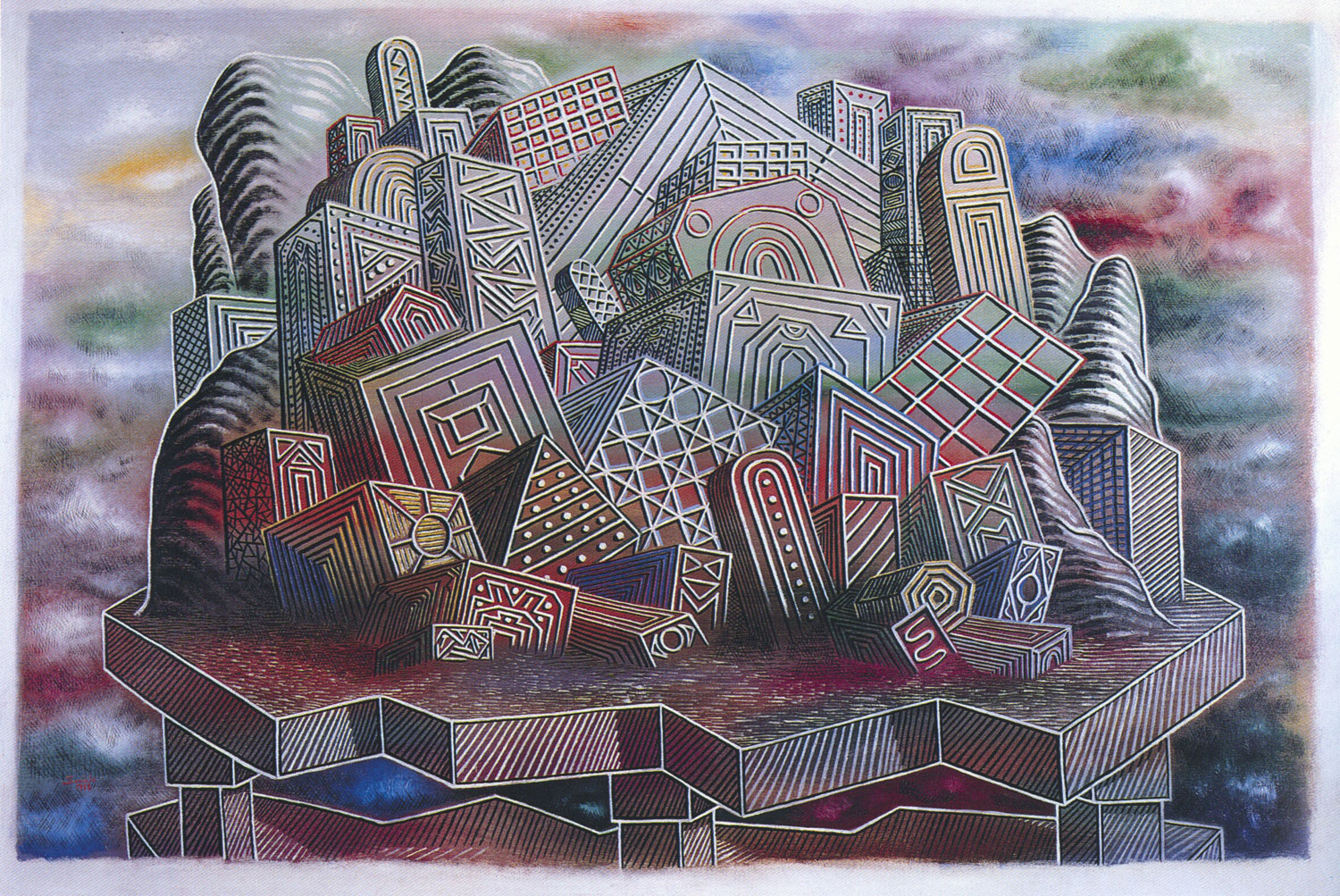<Back to Index>
- Mathematician Helmut Hasse, 1898
- Writer and Painter Alberto Savinio (Andrea Francesco Alberto de Chirico), 1891
- 2nd President of Ireland Seán Thomas O'Kelly, 1882
PAGE SPONSOR
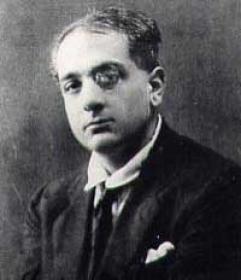
Alberto Savinio, real name Andrea Francesco Alberto de Chirico (25 August 1891 - 5 May 1952) was an Italian writer, painter, musician, journalist, essayist, playwright, set designer and composer. He was the younger brother of 'metaphysical' painter Giorgio De Chirico. His work often dealt with philosophical and psychological themes, and he also was heavily concerned with the philosophy of art.
Throughout his life, Savinio composed five operas and authored at least forty-seven books, including multiple autobiographies and memoirs. Savinio also extensively wrote and produced works for the theater. Savinio’s work received mixed reviews during his lifetime, often due to his pervasive use of surrealism. He was influenced by and a contemporary of Apollinaire, Picasso, Jean Cocteau, Max Jacob, and Fernand Léger.
Born in Athens, Andrea De Chirico was the third child of Evaristo De Chirico and Emma Cervetto De Chirico (a Genoese noble). At the time of his birth, Andrea’s parents were living as Italian expatriates in Greece while his father worked as an engineer for the Societé des Chemins de Fer de la Thessalie, working on the Greek railway system.
His older brother, three years his senior, was the renowned artist
Giorgio De Chirico. Andrea also had an older sister named Adele who
died six months before his birth. Later in his life, Andrea would
reflect upon his foreign birth as a special opportunity to determine
his own destiny through determination of his own national identity. Andrea was primarily homeschooled by
his mother, while living in Greece. He often depicts his father as
educationally restrictive, authoritarian and oppressive. Partly due to
his restrictive learning environment at home, Andrea learned to love Greece. At a young age he became enthralled by the Ancient Greek ruins and culture,
which were conducive to creativity and fantasy during his childhood. As
a result, Andrea would later often credit Greece for his love of critical thinking and irony.
In addition to his homeschooling, Andrea also enjoyed a strong musical education. At the age of twelve, he graduated from the Athens Conservatory with a concentration in piano and music composition. When he was fourteen, his father died. In response, Andrea composed a Requiem in his father’s memory. Andrea’s family then returned to their ethnic homeland of Italy. Staying in Italy only briefly, the family again relocated, this time to Munich, Germany. While living in Germany, Andrea began to be tutored in piano and composition by renowned musician Max Reger.
While under Reger’s tutelage, Andrea composed his first piece to
receive critical acclaim, a three act opera, Carmela; as well as an
opera of lesser acclaim, Il tesoro del Rampsenita. Carmela was quickly noticed by composer Pietro Mascagni, and music publisher Ricordi. By 1911,
when Andrea was twenty, his music had become popular enough to be
performed in public in Munich. The same year, Andrea set out on his
own, moving to Paris, France, an epicenter of activity for the European Avant-Garde and Modernist movements. In Paris, he befriended Guillaume Apollinaire, one of the foremost poets, critics,
and artists at large in the Avant-Garde movement. While living in
Paris, Andrea also became acquainted with a range of writers and
artists such as Pablo Picasso, Jean Cocteau, Max Jacob, and Fernand Leger. Andrea developed an interest in the art of mime during this period, as well. In 1914, largely in an effort to differentiate himself from his increasingly famous artist - brother, Giorgio De Chirico, Andrea adopted the penname Alberto Savinio. Savinio founded the musical movement Sincerismo (Sincerism) this same year. Sincerismo largely abandoned polyphony and harmony in favor of dissonance and rhythm as its primary musical characteristics. That year also saw the publication of Les Chants de la mi-mort (The Songs of Half-Death), a dramatic poem including original illustrations and a piano suite accompaniment, both also created by Savinio. Les Chants de la mi-mort was written primarily in French, but also included passages written in Italian.
The poem consisted of a single act, containing four loosely linked
scenes. Les Chants de la mi-mort dealt largely with the concept of sleep (interpretatively
referred to as “The Half Death”) and was filled with odd, mechanical
toy-like characters. This poem is often considered one of the most
important of the 1910’s surrealist movement; as a result, Savinio is often considered one of the founders of the Surrealist movement.
Shortly after the outbreak of World War I, Savinio and his brother returned to Italy in order to enlist in the Italian army. After enlisting, the pair was sent to the military hospital in Ferrara, Italy, where they met Carlo Carrà. This group of three, under the influence of Giovanni Papini, then proceeded to found the artistic movement Schola Metafisica (Metaphysical
School). Schola Metafisica became known as one of the most significant
artistic experiences of twentieth century Italy. In 1917, Savinio was sent to Greece as
an interpreter for Italian troops. While stationed there, Savinio
gained the chance to rediscover his childhood play world of Greece, and
the influence can be seen in his first published novel, Hermaphrodito. Hermaphrodito was published in 1918, and like Les Chants de la mi-mort, was a multilingual piece, intertwining languages as well as prose and poetry.
Hermaphrodito was also a meld of autobiography, fiction, thoughts and
fantasies; it has even been called a war journal, as it often deals
with specific experiences from WWI. Savinio claimed a very personal
connection to the novel, once stating, "Tutto che io sono nasce da li.
Tutto che ho fatto viene da li" (Everything that I am springs from
there. Everything that I have done comes from there.). After WWI,
Savinio relocated to Rome. In 1920,
Savinio completed Tragedia del l’infanzia (Tragedy of Childhood), a
primarily autobiographical collection of episodes illuminating the
disconnect between the adult and juvenile experience and perception of
the world. Each of the episodes in Tragedia del l’infanzia presents a
situation in which the world of adults and “artistic” creativity is
contrasted with the world of childhood imaginings. Tragedia del
l’infanzia was finally published in 1937. In 1924, the Metropolitan Opera of New York performed his ballet Perseus. 1925 saw
the publication of his second novel, La Casa Ispirata (The Haunted
House). Set in 1910 Paris, the novel tells the story of the
protagonist - narrator, who is apparently renting a room from a typical bourgeois house,
which Savinio describes as being “inhabited by Ghosts.” The novel is,
in many ways, a darkly comic and grotesque revue of modern life. The
scenes of the novel, are at once hyper real and fantastically abstract,
with great attention being given to the unconscious. This year also brought the beginning of collaboration with his brother in Pirandello’s Teatro d’Arte in Rome, Italy. The theater had
always been a favorite medium for Savinio as it was in many ways a
crossroads of the visual, musical and linguistic creativities. Savinio immersed himself in every aspect of the Theater, from scripting, to set design. While
working at the Teatro d’Arte he wrote Capitan Ulisse, a three act drama
considered fundamental to his body of work. The play was advertised in 1926, but not actually performed due to problems in the theater company. The play was eventually published in 1934, and staged at the Anton Giulio Bragaglia Theater in Rome in 1938. Also while working at the Teatro d’Arte, Savinio met Maria Morino, and proceeded to marry her the following year. In 1926, Savinio returned to Paris, and began to paint seriously. In 1927, he gave his first one man show as a painter, at the Bernheim Gallery in
Paris. Savinio’s contributions to the Avant-Garde movement during this
period sharply contrast with the provincialism that was favored by the
National Fascist Party in Italy at this time. Angelica o la Notte di
Maggio (Angelica or the Night in May), which was a parodical and
surrealist revisitation of the Ancient Greek myth of Eros and Psyche was
published this year, as well. The novel tells the story of Angelica - a
poor actress working in a second rate theater in Greece at the end of
the nineteenth century and Baron Felix Von Rothspeer, a loveless, older
aristocrat. In many ways, Savinio makes the theater a central character
in the plot; it is painted as a place where the senses and romance can
be deeply explored and discovered. In 1928, Savinio’s daughter, Angelica, was born in Paris; his son was then born in 1934. Both of his children were named for characters from Ludovico Ariosto’s Orlando Furioso (1516). During this period of his life, he was primarily occupied with literary, musical and artistic criticism.
Infansia di Nivasion Dolcemare (Infancy of Nivasion Dolcemare) was published in 1941.
This was and is considered one of Savinio’s finest novels, containing a
witty but intensely narrative driven style, and unsurprisingly,
extensive discussions of the Philosophy of Art. 1950 saw
the publication of two more opera’s by Savinio, Orfeo vedova and
Agenzia Fix. Savinio completed his fifth and final opera, Cristofor
Colombo, shortly before his death on May 5, 1952 in Florence, Italy. The penname "Alberto Savinio" was an “Italianization” of Albert Savine, a minor French writer and translator of Oscar Wilde and Thomas De Quincey.
Savinio chose this name partly because Savine was a relative unknown in
the literary world. Savinio believed that the selection of a penname
allowed him a moment of self determination; something in which he could
chose his own destiny. For Savinio, being an ethnic and cultural
Italian was much like a cultural penname for him. In his somewhat
autobiographical novel, Infanzia di Nivasio Dolcemare ("The Infancy of Nivasio Dolcemare"), Savinio would reflect upon the fact that: as
an Italian born outside of Italy, Nivasio Dolcemare considers himself
privileged. This "indirect" birth is an ironic situation, as stylistic
solution, a condition that has added certain nuances, certain
subtleties, certain half and quarter-tone passages to the national
faculties of the man Dolcemare which "direct" birth would not have
permitted… Italian more Italian than the Italian since the "Italian" in
him is not a "place of birth," but a condition discovered, wanted, conquered. Early in their lives, Andrea and his brother, Giorgio were nearly inseparable, even referring to themselves as Castor and Pollux,
the warrior twins. As children, there was tremendous collaboration
between the brothers that led to strong overlap of themes later in
life. The most well noted of these overlapping themes was that of the
mythical Greek Argonauts, as a metaphor for their development and journey as artists. There
is evidence to suggest, however, that their relationship frayed in later
life. Although their deceased sister Adele appears in and is mentioned
frequently in Savinio’s memoirs and autobiographies, Giorgio fails to
appear at all in any of them. Judgments
of Savinio’s work varied wildly according to phase his life and the
reviewer. Many of Savinio’s most critically praised works are also
amongst his most disliked and misunderstood. This is largely due to
Savinio’s frequent and controversial use of Surrealism and Sincerism as media for creative expression. From
a very young age, Savinio’s piano playing impressed critics nearly
unanimously. Guillaume Apollinaire once said of Savinio’s piano playing: I
was surprised and beguiled; Savinio mistreated his instrument so much
that after each piece the keyboard had to be cleared of chips and
splinters. I foresee that within two years he will have gutted every
piano in Paris. Savinio will then go on to destroy every piano in the
universe, which may be a true liberation. Judgment of his body of work as a whole was seen in 1954, when the Venice Biennale created a room devoted solely to Savinio’s artistic legacy. In
recent years, Savinio’s works have seen something of a revival. This
posthumous rebirth of Savinio’s work can be largely attributed to a
growing understanding of Surrealism in the public consciousness. It is
fair to say that in many ways Savinio was well before his time, a fact
that both distinguishes him and accounts for much of the negativity
amongst his contemporary critics.
